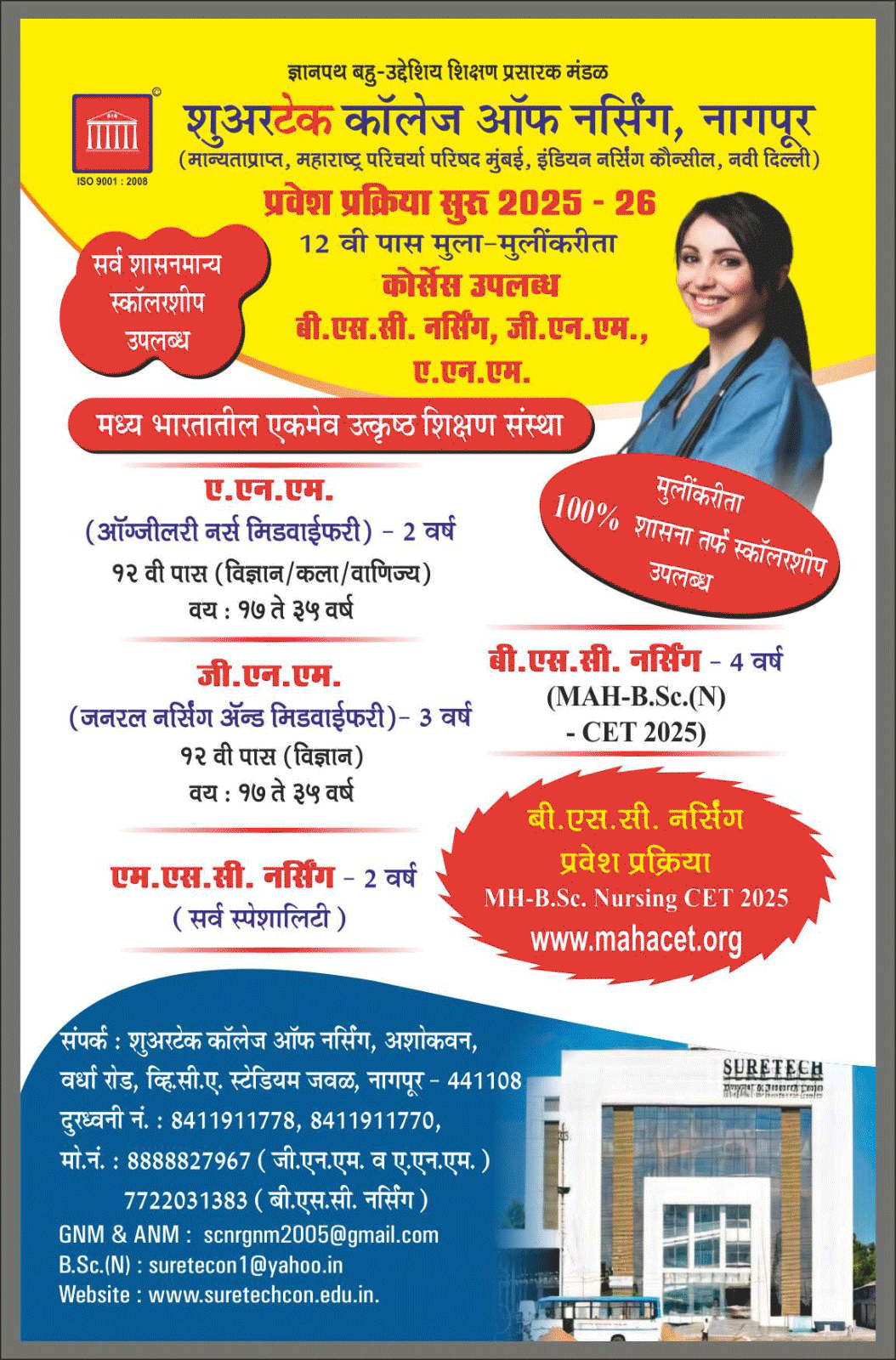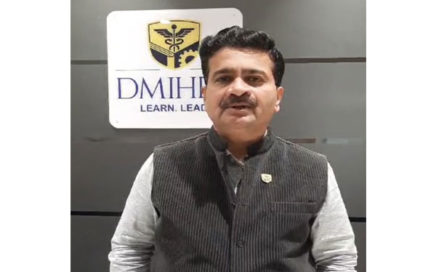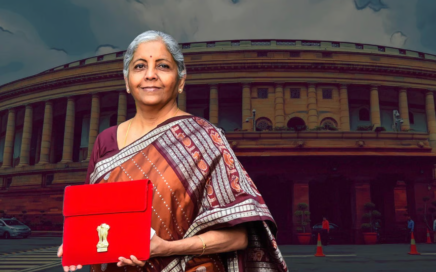Nagpur: The Union Budget 2025 presented by Finance Minister Nirmala Sitharaman on Saturday, February 1, has been hailed by experts from various fields in Nagpur.
It’s a broad based growth oriented budget –CA Julfesh Shah
CA Julfesh Shah, Chairman, COSIA, Vidarbha, called the budget a broad based growth oriented budget with consumption booster focussing on agriculture, MSMEs, Investments, Exports, Tourism, Urban Sectors, Labour intensive sectors, startups, skill development & innovations, Make in India.
Shah further said, it’s a budget which announced the biggest tax changes since 1997. Simplification & reducing litigation are the key objects in direct tax proposals & announcement that new direct tax code will be put in place in the time to come. Special announcements for MSMEs will act as a booster for the weaker MSME sector.
“Allowing Private Public Partnership (PPP) in various sectors including infra development will prove to be very positive & ensure economic growth & job creations in the long run. No income tax up to Rs 12.75 lakh for salaried taxpayers is a big ticket change and will in turn boost the savings & consumption,” Shah said.
Veteran farm activist Kishore Tiwari hails budget
Veteran farm activist Kishore Tiwari who has been tracking agrarian crises in cotton growing region of Vidarbha which is epicentre of farmers suicides and is reporting 8 farmers suicides a day since 2001 has welcomed the budget presented by Finance Minister Nirmala Sitharaman which has addressed the core issues of input cost regulations, introduction of cotton mission to enhance the productivity and promote pluses and oilseeds in mission mode.
Finance Minister Nirmala Sitharaman announced a ‘Dhan Dhyan Krishi’ scheme and said it will help over 1 crore farmers in the country and ‘PM Dhan Dhyan Krishi Yojana’ will cover 100 districts with low yields, modern crop intensity and below-average credit parameters,
Tiwari welcomed the decision of Govt to launch rural prosperity, resilience Programme focusing on youth, women and farmers and to launch a 6-year program for Atma Nirbharta in pulses with special focus on tur, urad, and masoor. A comprehensive programme for raising vegetables, fruits production, and providing remunerative prices is a good move and a proposed national mission of high yielding seeds will be launched along with a 5-year mission to promote cotton production.
Tiwari welcomed the decision of the Govt to enhance the limit for interest subvention scheme for Kisan Credit Card from Rs 3 lakh to Rs 5 lakh, this will restore credit cycle . its need of hour to adopt crop diversification and sustainable agricultural practices and to augment post-harvest storage at panchayat and block level and Improve irrigation facilities.
Tiwari also welcomed the budget to initiate reforms in 6 domains which are taxation, urban development, mining, financial sector, power and regulatory reforms, announcement of No tax will be payable on income up to Rs 12 lakh, is providing significant relief to taxpayers especially the middle class, Tiwari said .
Tejinder Singh Renu thrilled
Tejinder Singh Renu, President, Nagpur Residential Hotels Association (NRHA), said, “I’m thrilled to see tourism finally receiving the attention it deserves, thanks to the Modi Government’s focused efforts. For decades, tourism has been overlooked in most budgets, but that’s about to change. With India’s rich tapestry of historic and natural landscapes, from lush jungles to serene seashores and majestic mountains, we’re poised to attract a surge of domestic and international tourists, generating substantial revenue for the country.”
Renu further said that the government’s plans to develop the top 50 tourist destinations in partnership with states will undoubtedly boost tourism. Granting infrastructure status to hotels, even if only in limited areas, is a step in the right direction. Moreover, initiatives like intensive skill-development programs for youth, including those in Institutes of Hospitality Management, and providing MUDRA loans for homestays, will uplift the sector.
Other notable decisions include improving travel ease and connectivity, streamlined e-visa facilities, visa-fee waivers for select tourist groups, and a special focus on destinations related to Lord Buddha’s life. The promotion of Medical Tourism and the “Heal in India” initiative, in partnership with the private sector, will also receive a boost. Additionally, performance-linked incentives for states will encourage effective destination management, including amenities, cleanliness, and marketing efforts.
“In the same lines, I am sure the recently inaugurated Tourism Policy in Maharashtra will be implemented soon as the same got delayed due to State Elections. Such a combination of Centre and State will surely take the Tourism sector to a remarkable height,” Renu asserted.
Dr. Dipen Agrawal, President, Chamber of Associations of Maharashtra Industry & Trade (CAMIT)
As the President of CAMIT, I commend Finance Minister Nirmala Sitharaman for presenting a budget that prioritizes economic growth, fiscal prudence, middle-class empowerment, and industrial development. The reduction of the fiscal deficit to 4.4% of GDP ensures long-term stability, while the increase in the nil tax slab to ₹12 lakh is a much-needed relief that will boost disposable income, drive consumption, and benefit trade and industry.
For MSMEs, the National Manufacturing Mission and start-up funds are welcome steps toward incentivizing manufacturing, innovation, and infrastructure development. The decision to raise the investment and turnover limits for MSMEs is a progressive move that acknowledges the sector’s evolving needs. However, more targeted interventions—especially in terms of credit accessibility, cost reduction, and compliance simplification—are necessary. Special packages and tax incentives for Vidarbha and Marathwada could have further fuelled industrial growth in these regions.
The farm sector sees a major boost with the launch of five-year Cotton and Pulses Missions, ensuring 100% government procurement — a gamechanger for Vidarbha, where cotton and tur dal are primary crops. This initiative will strengthen the agro-value chain, enhance rural incomes, and create new economic opportunities. Additionally, higher subsidized credit limits for farmers and policies promoting high-yielding crops align with the vision of improving farm productivity and income security.
The decision to raise the FDI limit in insurance to 100%, along with key reforms in taxation, power, urban development, and mining, signals a comprehensive economic approach. However, it is disappointing that Maharashtra—the highest contributor to India’s GDP and tax revenue—has been largely overlooked, while states like Bihar receive significant allocations ahead of elections. Maharashtra’s industrial and agricultural sectors deserved greater attention and incentives.
As with any budget, there are hits and misses. Some expectations were met, while others remained unfulfilled. The budget lays a solid foundation for growth, but its impact will depend on effective implementation and continuous stakeholder engagement. Overall, I rate this budget 7 out of 10.
Vishal Agrawal, President, Vidarbha Industries Association
It is a very encouraging budget and shows the government’s focus on strengthening the economy. The focus on four key sectors—agriculture, MSMEs, investment, and exports — indicates the visionary roadmap towards PM Narendra Modi’s vision of a ‘Viksit Bharat.”
The Budget has provided a significant boost to the MSME sector by significantly raising the thresholds for capital investment and turnover criteria for classification as Micro, Small, or Medium enterprises, Combined with the enhanced credit guarantee scheme, this move is expected to drive increased capital investment. This would help MSMEs to modernise and expand their operations.
The emphasis on infrastructure initiatives and overall capex estimates are significant. The special mention here is for the ability to manage fiscal prudence and reduced fiscal deficit projections in FY25E and FY26. This makes the sustenance of growth more probable and long-term”. Focus on Start up and Make in India scheme is worth mentioning which will enhance domestic production and self-reliance.
Increase in Income tax Slab rate will be a big relief to all the taxpayers especially the lower income, middle income people, it will definitely give much bigger impetus on urban consumption, and also over a period of time, greater amount of private capex will get facilitated through this, so it is a positive change, and much required. People were getting affected because of high interest rates, inflation, it’s a good relief to people.
Prashant Mohota, Hon. Secretary – VIA
Mohota asserted that the overall impact of the budget is positive.
Budget Allocation steeply up from FY 24-25 revised figures of Rs 3342 crores to Rs 5252 crores (mainly increased for ATUF & PLI which means incentive funds with flow to industry faster). Cotton Mission of 5 years announced to boost productivity & production – today India has no surplus in cotton and has one of the lowest yields of 450kgs/hectare against global average of 800kgs plus – big boost to cotton based industry.
Flat 20% or Rs 115/kg import duty, whichever is higher, imposed on all knitted fabric HS codes – means no scope for leakages and any fabric below Rs 575/kg would attract import duty of Rs 115/kg – will stop undervalued fabrics into the country – PLUS for the local MMF based industry. Shuttleless looms added to the import duty exemption list of Technical Textiles Machinery. Consumption driven budget with higher money in the hands of the middle class means more buying of apparels and home textiles. Textiles is predominantly in the MSME segment with many women entrepreneurs – all schemes for their benefits would directly impact textile manufacturing.
CA Rajesh Loya, Loya Bagri & Co.,
Loya said that the Government’s effort is to have a litigation free environment in tax system. Less Compliance while making tax compliance. Discrimination of certain provisions of tax and trusting the taxpayers.
Dr Anita Rao, former Joint Secretary – VIA & Chairperson – VIALEW
Substantial funds to support private sector research and fund of funds for deep-tech start-ups is great news. New scheme for SC/ST women Entrepreneurs will certainly give a great boost to them. Similarly the funding support for the tourism sector will give them some extra teeth. New income tax bill supposed to contain the ‘ spirit of nyay’ is eagerly awaited. Overall a good and balanced budget.
CA Adv Sachin Jajodia, Convener – VIA Taxation & Corporate Law Forum
This budget focused on middle class persons and specially the seniors which was the need of the hour by providing more disposal money into the hands of the middle class through meaningful tax reliefs. Increase in disposable income is a positive move that will strengthen purchasing power and which in return boosts the economy through higher indirect tax collections, which is the main source of revenue for the Government. Thus reduction of deficit as well as moving through a 5 trillion economy will be pumped.
There were many welcomed announcements with regard to driving innovation across sectors like fintech, health tech, and clean energy, providing crucial support for early-stage startups that face difficulties securing private investments.
CA Advocate Sachin Jajodia
This budget was focused on the middle class, particularly senior citizens, addressing the need of the hour by providing meaningful tax reliefs that increase disposable income. The rise in disposable income is a positive step that will strengthen purchasing power and, in turn, boost the economy through higher indirect tax collection, which remains the government’s primary revenue source. This approach will aid in deficit reduction while propelling India toward a $5 trillion economy.
Several welcome announcements were made to promote innovation in sectors such as fintech, health tech, and clean energy. These measures provide crucial support to early-stage startups that often struggle to secure private investment.
CA Saket Bagdia, Bagdia & Company
Bagdia highlighted the key aspects of the budget calling it a good growth-oriented Budget, and the middle class benefited by Tax Rate cuts. MSME sector definition upward revision is an important step and CGTMSE scheme extension is a welcome step.
CS Sarrah Katawala, Chairperson – Nagpur Chapter ICSI (Institute of Company Secretaries of India) said that the bold move for the middle class was required. By exempting IT up to 12 lakh is a welcome move. Increasing the mega from 5 to 10 years for charitable organisations is also a needed relief. Some cases in compliance are still required by increasing online filings in this sector. MSME will also be motivated by an increase in the loan limit from 10 cr to 20 cr. Overall, it is a happy budget.
















